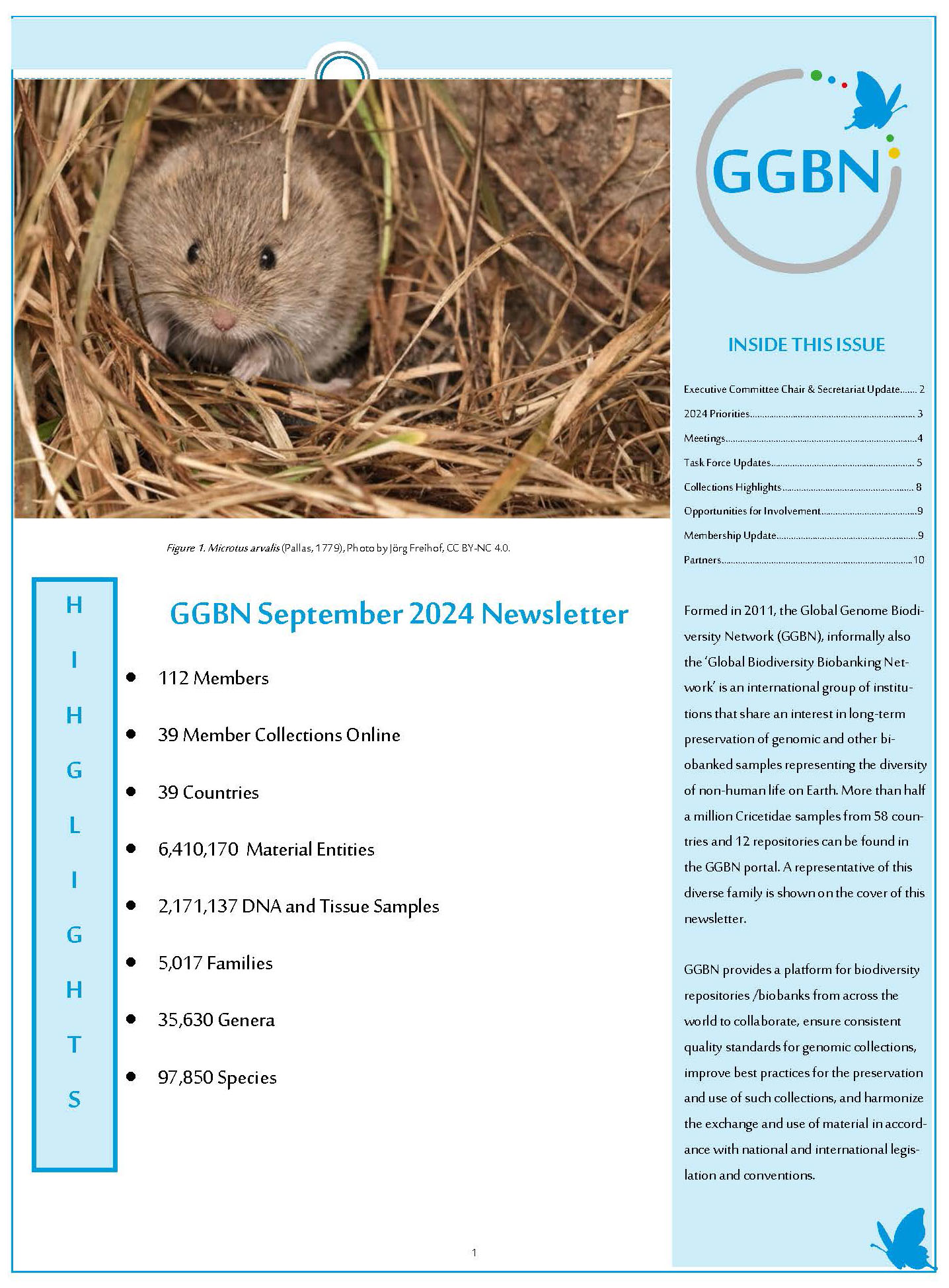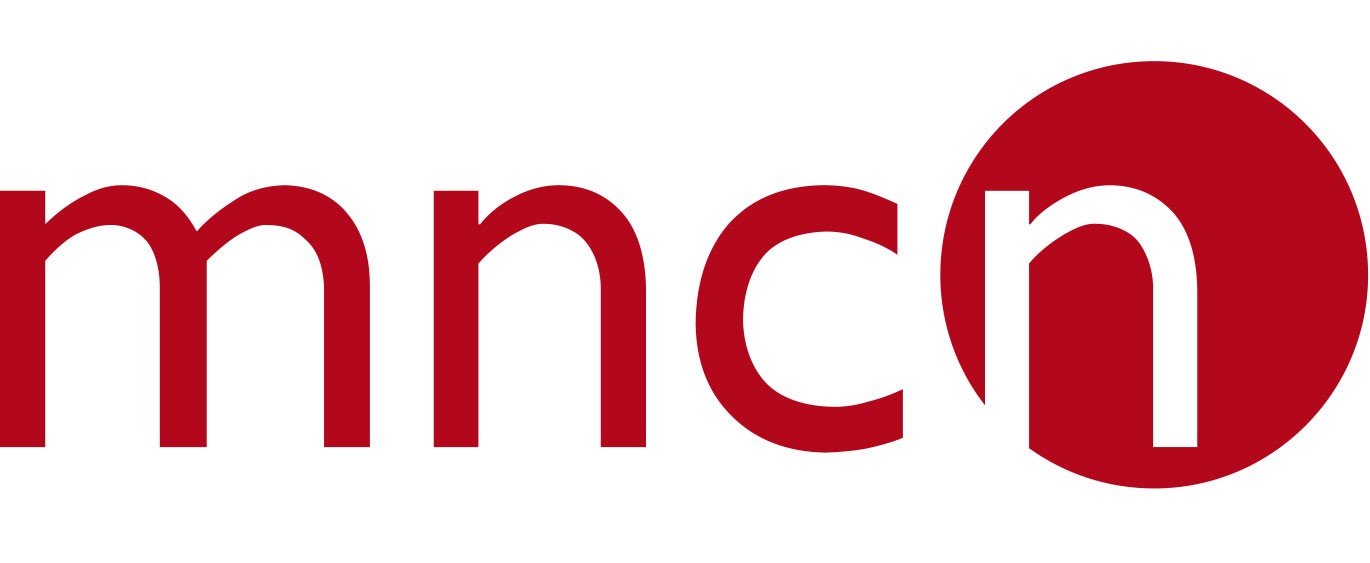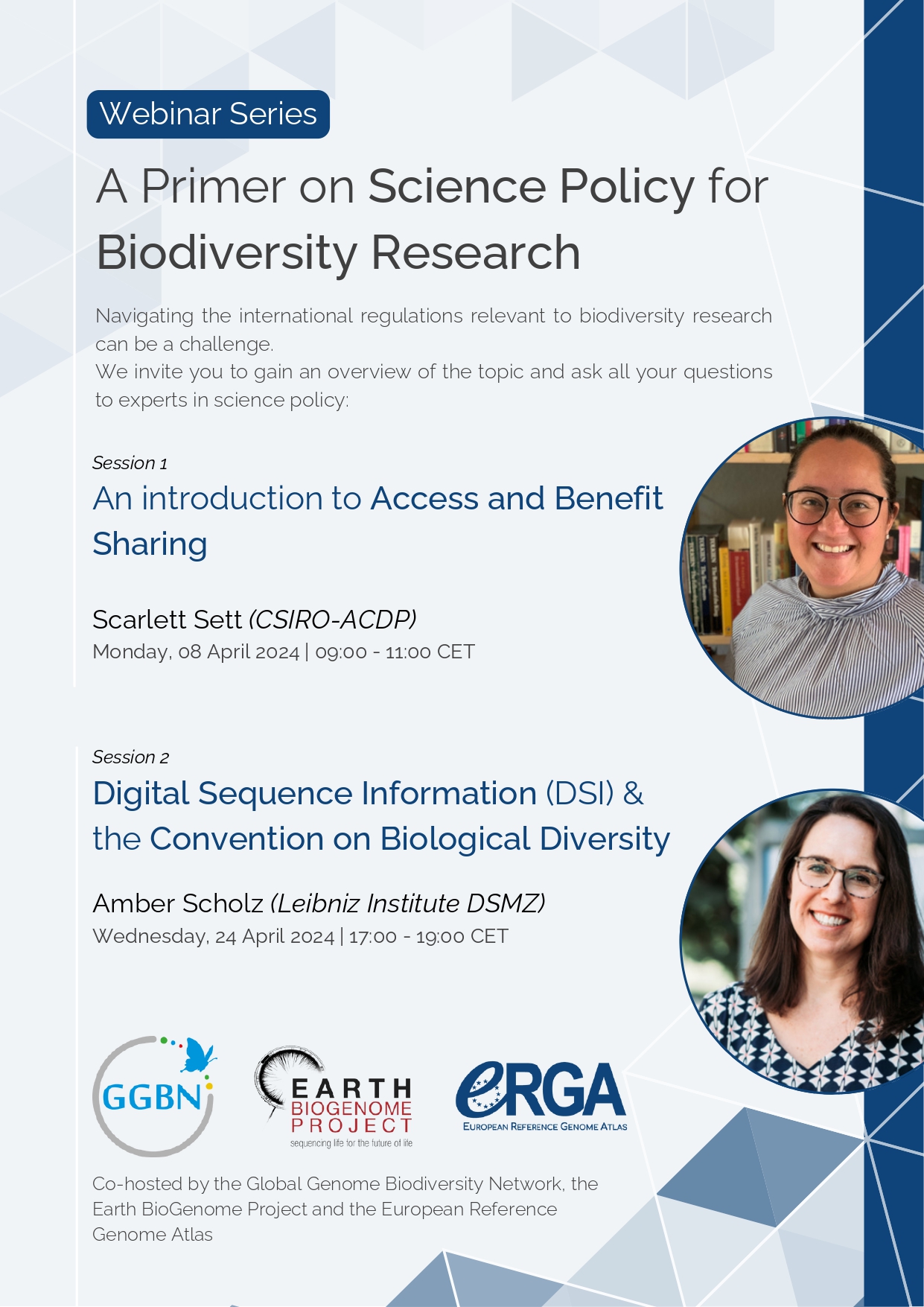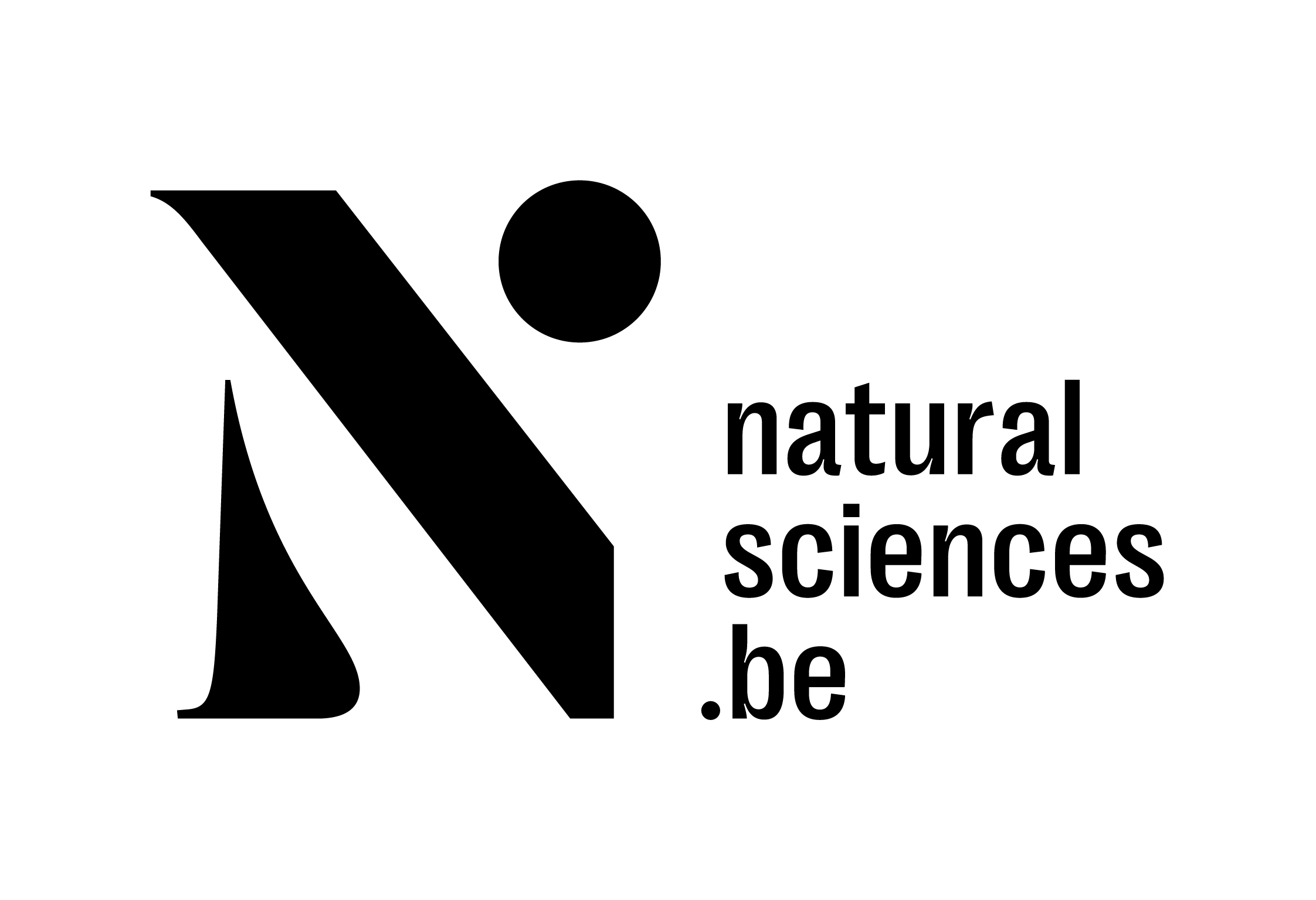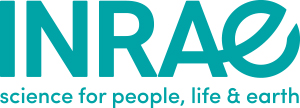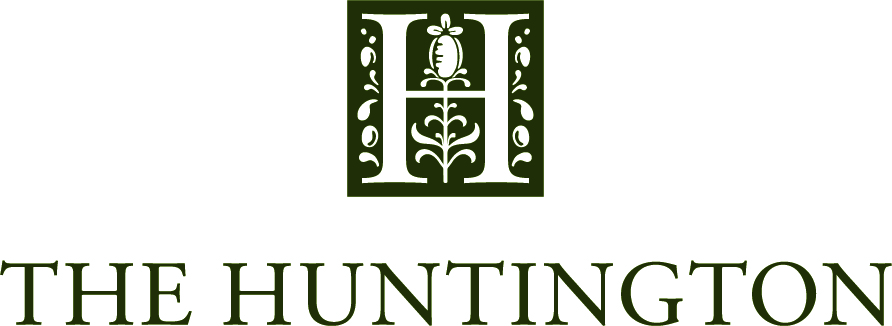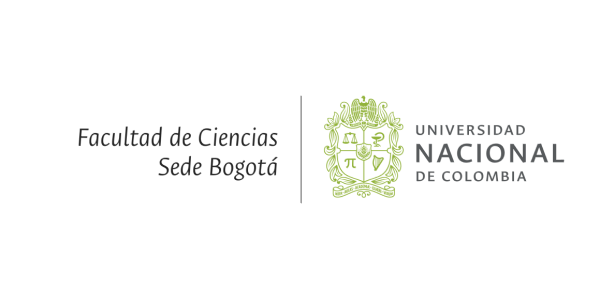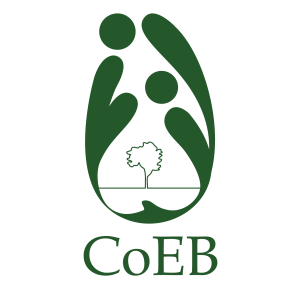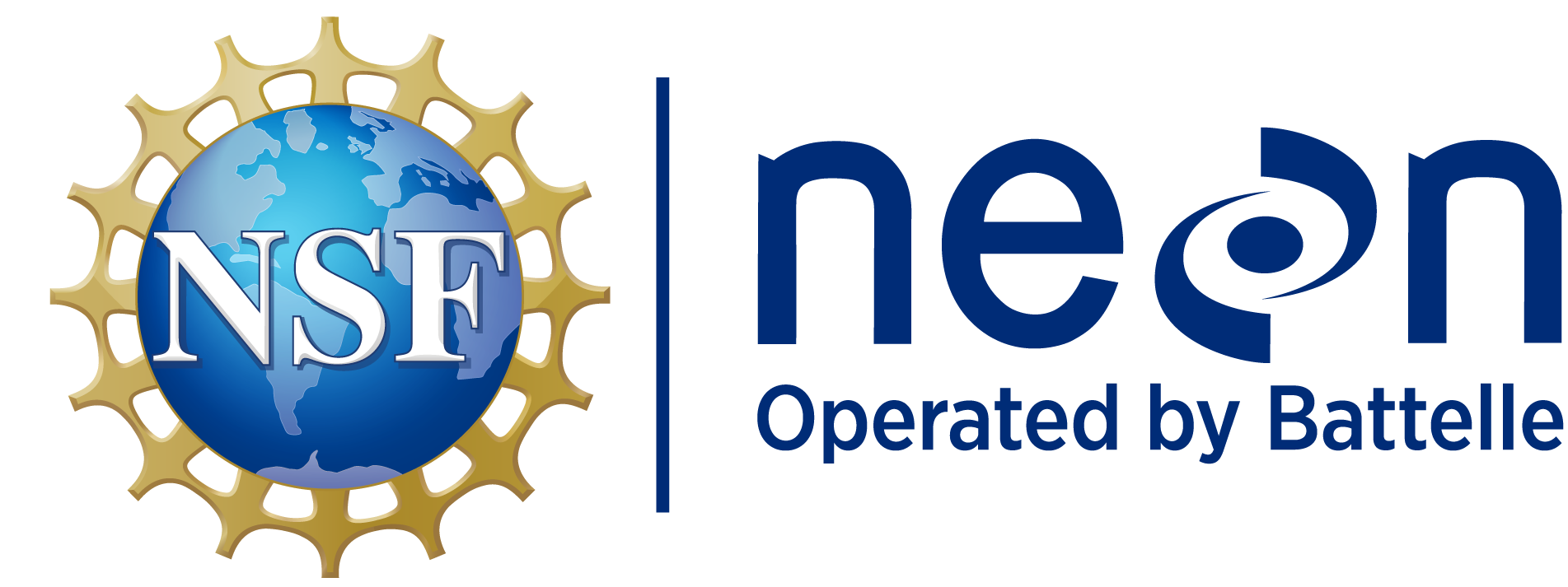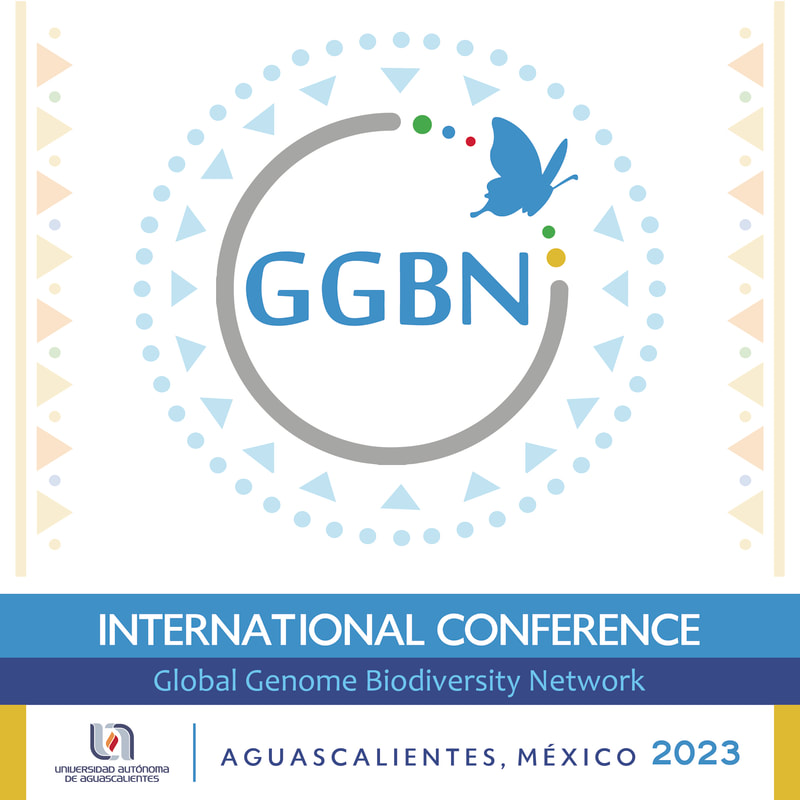|
|
| (305 intermediate revisions by 6 users not shown) |
| Line 1: |
Line 1: |
| − | =08 July 2019-University of Karachi joins GGBN= | + | ==October 30 2024 The Earth BioGenome Project has updated their guidances for Sample Collection and Processing! == |
| − | We are pleased to announce that the University of Karachi, Centre for Plant Conservation has joined GGBN as part of the GGBN-GGI 2019 Awards Program. The awarded project will publish 1,000 samples representing different areas of Pakistan representing a diversity of biotic communities and relatively rich flora.
| |
| | | | |
| − | [[File:Karachi_University_logo.png|center|400px]] | + | The Earth BioGenome Project (EBP) Sample Collection and Processing subcommittee has updated their guidance on all things you need to think about when collecting and preparing specimens that will be used to generate high quality reference genomes. Check it out [https://library.ggbn.org/share/s/y2ovOIbJSIqkg22e1nt1Bg here!] |
| | | | |
| − | =01 July 2019-Job Advertisement-Cell Culture Specialist-Zoological Research Museum A. Koenig= | + | ==October 15 2024 Universidad Autónoma de Aguascalientes publishes data through GGBN!== |
| − | The Biobank at Zoological Research Museum A. Koenig in Bonn, Germany, is looking for a full-time cell culture specialist. The position can be filled immediately and is funded for three years within the project "Forensic Genetics for Species Protection", aimed at protecting endangered animals. Tasks include:
| |
| − | *Establishing cell cultures and cryopreservation
| |
| − | *Developing methods and coordination of lab workflows, especially for cell culture; data analyses
| |
| − | *Management of the cell culture lab; responsible for instruments
| |
| − | *Handling biobank samples (incl. DNA, tissue): documentation, databasing, preparation, preservation
| |
| − | *Sample acquisition & research: international correspondence on samples; organizing logistics
| |
| − | *Supervision of research assistants, students, and interns
| |
| − | Your profile:
| |
| − | *Extensive, documented hands-on experience in the cell culture lab (ideally, but not necessarily with animals)
| |
| − | *Finished vocational training or university degree in life sciences
| |
| − | *Capacity to organize and manage molecular infrastructures and projects
| |
| − | *Good IT skills (esp. with spreadsheets, database knowledge)
| |
| − | *Fair knowledge of the English language for international correspondence etc.
| |
| − | *High interpersonal skills; most meticulous and responsible, proactive way of working; competent at problem-solving
| |
| | | | |
| − | ZFMK offers a highly motivating environment at a renowned and pioneering research facility and the possibility to work independently. Salary and benefits are according to a public service position in Germany, TV-L E 9.
| + | We are excited to announce that Universidad Autónoma de Aguascalientes (UAA) has published data for the first time through GGBN! There are 2,000 botanical DNA and tissue samples collected in Central Mexico now available online. Check it out [https://www.ggbn.org/ggbn_portal/search/result?institution=UAA%2C+Aguascalientes here]! |
| | | | |
| − | Equally qualified severely disabled applicants will be given preference.
| + | ==October 9 2024 The slides from the SPNHC-TDWG 2024 Conference are now available! == |
| | | | |
| − | Please send your application by e-mail attachment, including a detailed CV, until July 19, 2019 to Mrs. Heike Lenz: h.lenz@leibniz-zfmk.de. In case of questions concerning the position please contact Jonas Astrin: j.astrin@leibniz-zfmk.de, tel. +49-228-9122 357.
| + | Slides from the SPNHC-TDWG 2024 Conference session on "Biodiversity Biobanking Network GGBN: A global infrastructure for molecular collections" are now available on the GGBN document library. Check it out [https://library.ggbn.org/share/s/sLmM-4MXQ2mkSsasxojhZA now]! |
| | | | |
| − | For more information about ZFMK see http://www.leibniz-zfmk.de/en
| + | ==October 9 2024 The 2024 GGBN Newsletter is now available! == |
| | | | |
| − | =18 June 2019-The University of California, CALeDNA Program joins GGBN=
| + | We are excited share the latest edition of the GGBN Newsletter is now available! Within the 2024 GGBN newsletter you'll find all the highlights, updates, and events that have shaped our community over the past year. We hope you enjoy this [https://library.ggbn.org/share/s/HCsKPlHXQBaSD18NmEZNqg newsletter]! |
| − | We are proud to announce that the University of California, [http://www.ucedna.com/ CALeDNA Program] has joined GGBN. As part of the GGBN-GGI 2019 awards program, the project will develop pipelines for e-DNA collections to GGBN and GBIF, acting as a prototype model for other e-DNA collections and will work with GGBN to demonstrate best practices for e-DNA curation. Approximately 1,000 soil, sediment and water samples representing 18,000 species will be added to GGBN. | |
| | | | |
| − | [[File:Sticker Design 2019 v4.png|center|400px]] | + | [[File:GGBN_Sep2024_Newsletter.jpg|center|350px]] |
| | | | |
| − | =10 June 2019-Job Advertisement-Director of Biodiversity Banking - Institute for Conservation Research= | + | ==September 5 2024 Museo Nacional de Ciencias Naturales joins GGBN! == |
| − | The Institute for Conservation Research has recently posted a job opening for a [https://usr56.dayforcehcm.com/CandidatePortal/en-US/sdzg/Posting/View/422 Director of Biodiversity Banking]. The deadline for applications is Sunday, June 30, 2019.
| |
| | | | |
| − | =3 June 2019-GGBN-GGI Awards Program 2019 Recipients=
| + | We are pleased to announce Museo Nacional de Ciencias Naturales (MNCN) has joined GGBN! Museo Nacional de Ciencias Naturales is located in Madrid, Spain. |
| | | | |
| − | We are happy to announce the results of the GGBN-GGI 2019 Awards Program. A total of seven highly competitive proposals representing member and non-member institutions across four countries were received and ranked by a peer review committee representative of GGBN membership. The panel ranked the proposals on the following metrics: complementarity to existing collections on GGBN; the size, scope, and quality of the collection; the genomic novelty of the collections; adherence to GGBN best practices; the efficiency or cost-effectiveness of the proposal; contribution to the GGBN community; and the timeline for completion. The total funding requested was nearly 190,000 USD, and a little over 95,000 was awarded. Awardees will be contributing new genetic samples to the GGBN data portal by September 2020.
| + | [[File:Logo_mncn_2024.jpg|center|350px]] |
| | | | |
| − | GGBN-GGI 2019 Awardees include: | + | ==April 30 2024 GGBN and ERGA Webinar Series on Science Policy for Biodiversity Research on Youtube== |
| − | *Centro de Ornitología y Biodiversidad (CORBIDI)/Peru
| |
| − | *Missouri Botanical Garden/USA
| |
| − | *University of California, Los Angeles, UC Conversation Genomics Consortium/USA
| |
| − | *University of Karachi, Centre for Plant Conservation/Pakistan
| |
| − | *University of Torino, Dipartimento de Scienze della Terra/Italy
| |
| | | | |
| | + | Both parts of the GGBN, the European Reference Genome Atlas (ERGA) and the Earth BioGenome Project (EBP) series focused on ABS - Nagoya Protocol and DSI are now uploaded on YouTube! Check it out [https://www.youtube.com/playlist?list=PL4qmCfIUT9K-cgswMIZdd89p3ZUhol-OH here]! |
| | | | |
| − | The titles and abstracts of these proposals can be found on the GGBN [https://wiki.ggbn.org/ggbn/Global_Genome_Biodiversity_Network-Global_Genome_Initiative_Awards_Program awards program page], along with general award program information.
| + | [[File:Youtube-logo-2431.png|center|350px]] |
| | | | |
| − | Congratulations everyone!
| + | ==March 25 2024 GGBN and ERGA Hosts a Webinar Series on Science Policy for Biodiversity Research == |
| | | | |
| − | =28 May 2019 Call for Conference Host: GGBN 2022=
| + | We're happy to announce that GGBN and European Reference Genome Atlas (ERGA) with the support of Digital Sequence Information (DSI) network are organizing a two-part webinar series focused on ABS (Access and Benefit Sharing), the Nagoya Protocol and DSI this April. Join us by filling the registration form [https://www.cognitoforms.com/ERGAEuropeanReferenceGenomeAtlas/APrimerOnSciencePolicyForBiodiversityResearchWebinarSeries here]! Spots are limited. |
| − | GGBN’s Executive Committee is seeking a host organization for the 2022 conference. GGBN conferences are an opportunity to exchange knowledge on biodiversity biobanking, grow the community and facilitate best practices in genetic collections management and discoverability.
| |
| | | | |
| − | Emerging as a world leader in genetic collections databasing, the Global Genome Biodiversity Network (GGBN) is an international scientific research network of biodiversity biobanks that collaborate to ensure the long-term preservation and discoverability of genetic samples from all life. GGBN advocates for the value of genetic samples, both today and into the future, and addresses key challenges associated with the management and use of these important resources. Together, GGBN’s member institutions promote access to information about, and legal exchange of, the genetic samples that they maintain. Our strategic areas include genomic sample management and discoverability, best practices for genetic collections, knowledge exchange and training, and communications and outreach. So far GGBN conferences have taken place in London, England; Berlin, Germany; Vienna, Austria and Shenzhen, China and we are always looking forward to expanding to new continents, countries, and cities.
| + | [[File:ERGA_GGBN_Webinar-3_page-0001.jpg|center|350px]] |
| | | | |
| − | The hosting location should have good travel connections and be able to host 100-150 participants. The local organizer is responsible for the facilities and the execution of the conference and conference budget. The organizer also has to secure sufficient funding (the Organizing Committee can offer their assistance in seeking grants and soliciting vendors). Conference dates will be determined in cooperation between the Organizing Committee and the local organizers.
| + | ==February 1 2024 Royal Belgian Institute of Natural Sciences joins GGBN! == |
| | | | |
| − | Proposals to host the GGBN 2022 conference should include:
| + | We are pleased to announce the Royal Belgian Institute of Natural Sciences (RBINS) has joined GGBN! Located in Brussels, Belgium, the Royal Belgian Institute of Natural Sciences has 6,000 DNA samples, 6,500 tissue samples, and 38,000 specimens in their collections. |
| − | *Motivation. Describe your motivation and highlight the benefits.
| |
| − | *Budget. No real detail of the budget is required at this stage, however, the approach to hosting the conference and the resultant budgetary implications are required.
| |
| − | *Conference hosting options to include the possible venue/s, accommodations, meals, activities, and transportation options.
| |
| − | *Key attributes of the location and potential venues. Bullet points describing the advantages of the location and potential activities for attendees.
| |
| − | *Date options for the conference.
| |
| − | *Primary contact name and contact information.Preliminary list of names of members of the local organizing committee and their responsibilities.
| |
| | | | |
| − | Interested parties should submit their proposals to host the 2022 conference no later than December 1, 2019. Proposals will be reviewed by the Executive Committee and the 2022 host will be announced at the 2020 conference in Shenzhen, China.
| + | [[File:RBINS_logo_complet_(2).jpg|center|350px]] |
| | | | |
| − | [https://meetings.ggbn.org/conference/ggbn/2018/schedConf/program The Conference Program]from GGBN's 2018 conference is available as a reference.
| + | ==January 4 2024 2023 SYNTHESYS Biobanking Handbooks are Now Available! == |
| | | | |
| − | =23 May 2019 GGBN 2020 Conference May 11-15=
| + | The fourth (and last) publication of the GGBN-led SYNTHESYS+ work package NA3: "Molecular collections in the age of genomics – standards & |
| − | It is our pleasure to announce that GGBN 2020, the 4th Conference of the Global Genome Biodiversity Network, will take place in Shenzhen China, May 11-15, hosted by the [https://www.cngb.org/home.html China National GeneBank]. We hope that you can join us!
| + | processes" has been released! They are now posted to the GGBN Document Library. Click [https://library.ggbn.org/share/s/Ijs5AFkCSFquS7vZW96KMg here] to take a look! |
| | + | [[File:Synthesys-plus-logo.png|center|350px]] |
| | | | |
| − | [[File:CNGB_Introduction2.jpg|center|600px]]
| + | ==January 4 2024 2023 GGBN Report Now Available! == |
| | | | |
| − | =23 April 2019-Kostrzyca Forest Gene Bank joins GGBN=
| + | We are excited to announce that the GGBN December 2023 Report is now available! This report highlights GGBN contributions, conferences, online discoverability and more from the past year. Head to the [https://library.ggbn.org/share/s/YKaykzh2QD-q2yByCgMJqw GGBN Document Library] to take a look! |
| − | We are proud to announce that the [https://www.lasy.gov.pl/en Kostrzyca Forest Gene Bank] has joined GGBN as its first Polish member. The genetic collection comprises 11,525 plant and 52 animal tissues, 8,497 plant and 14 animal DNAs and 20,000-50,000 specimens representing 163 plant and 2 animal species. Samples are stored in cold rooms (-3, -10, -20C), Freezers (-80C) and cryogenic containers (vapors of liquid nitrogen). | |
| | | | |
| − | [[File:Logo_Kostrzyca.jpg|center|400px]]
| + | ==December 7 2023 Tissue Samples Made Discoverable Through GGBN== |
| | | | |
| − | =19 April 2019-GGBN-GGI Awards Due May 1=
| + | We are excited to announce the organizations who provided data for the first time in 2023: CMN, Ottawa, Canadian Museum of Nature, INRAE, Paris, National Institute of Research for Agriculture, Food and Environment, HNT, San Marino, The Huntington, and UNAL, Bogota, Universidad Nacional de Colombia / National University of Colombia. |
| − | Thinking your genetic collections should be more visible for research? Do you require staff or other resources to make this happen? If so, then apply to the GGBN-GGI 2019 awards program. Deadline for proposals is May 1st. See https://wiki.ggbn.org/ggbn/Global_Genome_Biodiversity_Network-Global_Genome_Initiative_Awards_Program
| |
| | | | |
| − | =12 April 2019-GGBN Focus Group Meeting, Washington DC=
| + | [[File:CMN.png|center|350px]] [[File:INRAE.jpg|center|350px]] [[File:HTG logo.jpg|center|350px]] [[File:UNAL logo 600x300.png|center|350px]] |
| | | | |
| − | GGBN members met this week at the National Museum of Natural History in Washington DC to 1) discuss GGBN's dues model and possible changes based on needs of the network and 2) to develop a marketing strategy to facilitate better communication with the research and collections communities. Member participants attended from Brazil, Canada, China, Denmark, Ecuador, Georgia, Germany, United Kingdom, United States. A report will be developed over the next few weeks and distributed to the Executive Committee and the 88 members of the General Assembly for review and comment this summer.
| + | ==December 6 2023 National Herbarium of Rwanda, University of Rwanda joins GGBN == |
| | | | |
| − | Thanks to everyone who participated this week!
| + | We are happy to announce that the National Herbarium of Rwanda[https://herbariumrwanda.ur.ac.rw/] at the University of Rwanda has joined GGBN. Collections include 50 eDNA and 20,000+ tissue samples representing plants, terrestrial invertebrates, and vertebrates. Samples are managed with Symbiota and Excel. |
| − | [[File:April2019FGMeeting.jpg|center|500px]] | |
| | | | |
| − | =02 April 2019-GGBN March 2019 Newsletter Published=
| + | [[File:Herbarium of Rwanda.png|center|350px]] |
| − | GGBN's [https://library.ggbn.org/share/s/R9H3V8IXSDqiTk1ZS6G89Q March 2019 Newsletter] is now available for your reading pleasure.
| |
| − | [[File:GGBN2019Newsletter.png|center|300px]] | |
| | | | |
| − | =18 March 2019-Botanical Research Institute of Texas joins GGBN= | + | ==The GGBN 2023 International Conference Presentations are Available to Watch on YouTube== |
| − |
| |
| − | We are proud to announce that the [https://www.brit.org/ Botanical Research Institute of Texas] has joined GGBN as its 22nd United States member. BRIT's biorepository opened in January of 2019 and will help lead the [https://ggi.si.edu/ggi-gardens Global Genome Initiative Gardens collecting program], which partners with arboreta, botanic gardens, and greenhouses worldwide to preserve the incredible diversity contained within these living collections.
| |
| − | [[File:BRITlogo.png|center|300px]]
| |
| | | | |
| − | =01 March 2019-National Biodiversity Cryobank of Canada, Canadian Museum of Nature joins GGBN= | + | The 2023 GGBN International Conference presentations are now available to watch on our YouTube page [https://www.youtube.com/watch?v=NfOFuKPmJMQ&list=PLxCMSf8YBiw8RZX6q-_cs-y0nM103_-Is here]! Check out some of the amazing talks from the conference! |
| | + | [[File:Youtube-logo-2431.png|center|350px]] |
| | | | |
| − | We are proud to announce that the [https://nature.ca/en/research-collections/collections/cryobank National Biodiversity Cryobank of Canada], Canadian Museum of Nature, has joined GGBN as its 3rd Canadian member. The genetic collection includes 4,500 DNA and 30,000 tissue samples representing microorganisms, plants, vertebrates, terrestrial invertebrates and marine invertebrates. | + | ==November 06 2023 GGBN 2023 GGBN Announces 2025 Conference Host== |
| | + | We are happy to announce the South African National Biodiversity Institute and Biodiversity Biobanks South Africa as the host for the 2025 GGBN Conference in Cape Town, South Africa! Learn more about the institute [https://www.sanbi.org/ here] |
| | | | |
| − | [[File:CMN.png|center|300px]] | + | [[File:Large SANBI Logo new.jpg|center|350px]] |
| | | | |
| − | =06 February 2019-GGBN-GGI Awards Program 2019 Call for Proposals= | + | ==October 16 2023 GGBN 2023 Conference Program Available Now== |
| − | We are happy to announce the call for proposals for the GGBN-GGI 2019 Awards Program. The program provides funding for projects that support the discoverability of new genetic collections through the Global Genome Biodiversity Network's Data Portal. The next submission deadline for proposals will be May 1 2019. The proposal review committee will consider requests for up to 30,000 USD with clearly articulated budget justifications. For more information on the GGBN-GGI awards program, including information on how to apply, please visit [https://wiki.ggbn.org/ggbn/Global_Genome_Biodiversity_Network-Global_Genome_Initiative_Awards_Program the Global Genome Biodiversity Network-Global Genome Initiative Awards Program Page].
| |
| | | | |
| − | =22 January 2019-Dr. Cecilia Koo Botanic Conservation Center joins GGBN=
| + | The 2023 GGBN International Conference program is now available to view [https://ggbn2023.weebly.com/conference-program.html here]! Click to see presentation details, recommendations to do during your stay in Aguascalientes (if in person) and more. |
| − | We are proud to announce that the [http://www.kbcc.org.tw/tw/ Dr. Cecilia Koo Botanic Conservation Center] has joined GGBN. The genetic collection includes 16,890 tissues and 3,609 DNAs of plants.
| |
| | | | |
| − | [[File:Kbcclogo.jpg|center|500px]]
| + | ==September 7 2023 Hybrid Registration for 2023 GGBN International Conference Available Now== |
| | | | |
| − | =12 December 2018-National Tropical Botanical Garden joins GGBN=
| + | The 2023 GGBN International Conference will now be hybrid for those who want to join via Zoom! Virtual participants can register for $50 on [https://www.etix.com/ticket/c/417BD8523BDDF67177ECE60A52B3A32E/hybrid-participation Etix]. There is also still time to register for those who want to attend the conference in person! Click [https://ggbn2023.weebly.com/registration--abstract-submission.html HERE] to register. |
| | | | |
| − | We are proud to announce that the [https://ntbg.org/ National Tropical Botanical Garden] has joined GGBN as its 86th member. The genetic collection includes 4,100 DNA and tissue samples representing 1,268 species of plants.
| + | ==August 11 2023 NEON Biorepository, Arizona State University joins GGBN== |
| | | | |
| − | [[File:NTBGLogo.png|center|200px]] | + | We are pleased to announce the [https://biorepo.neonscience.org/portal/ NEON Biorepository, Arizona State University] has joined GGBN. Located in Tempe, Arizona, the NEON Biorepository has 31,358 DNA samples, 43,814 tissue samples, and 104,564 environmental samples. |
| | | | |
| − | =03 December 2018-North Carolina Museum of Natural Sciences joins GGBN=
| + | [[File:NEON-NSF.png|center|350px]] |
| | | | |
| − | We are proud to announce that the [https://naturalsciences.org/ North Carolina Museum of Natural Sciences]has joined GGBN as its 85th member. The genetic collection includes over 40,000 tissue samples representing 1,793 species of vertebrates, terrestrial invertebrates and marine invertebrates.
| |
| | | | |
| − | [[File:NC.png|center|500px]]
| + | ==August 07 2023 GGBN 2023 Conference: Abstract Submissions and General Registration Close August 31st== |
| | | | |
| − | =28 November 2018-Call for Proposals to host GGBN 2022-2026 Secretariat and Technical Management Offices=
| + | We are still accepting abstracts for the upcoming GGBN International Conference on Biodiversity Biobanking, taking place 17-20 October 2023 in Aguascalientes, Mexico. Please see the latest conference announcement attached for session details. |
| − | GGBN is now accepting applications to host the GGBN Secretariat and Technical Management Offices starting January of 2022 for a period of five years. The submission deadline for proposals is the 1st of January 2020. Proposals will be reviewed by the Executive Committee and approved by the General Assembly. The [https://library.ggbn.org/share/s/71YqqqMuQQiXA3Eya00Uow proposal call] along with associated criteria for applicants can be found on GGBN's [https://wiki.ggbn.org/ggbn/Documents documents page]. We very much look forward to receiving your proposals.
| |
| | | | |
| − | =06 November 2018-Yale Peabody Museum of Natural History joins GGBN=
| + | Important deadlines: |
| | + | General registration closes August 31st, late registration is open from September 1-October 1. |
| | + | The last day to submit your abstracts is August 31st. |
| | | | |
| − | We are proud to announce that the [http://peabody.yale.edu/ Yale Peabody Museum of Natural History] has joined GGBN as its 84th member. The genetic collection includes 50,000 DNA and 75,000 tissue samples representing over 4,000 species.
| + | Please submit your abstracts and complete registration [https://ggbn2023.weebly.com/registration--abstract-submission.html HERE] |
| | | | |
| − | [[File:YPM.jpg|center|200px]]
| + | [[File:Logo-ggbn-uaa-2023.jpg|center|350px]] |
| − | | |
| − | =01 November 2018-GGBN presents its relevance to research at EBP launch this week=
| |
| − | | |
| − | The [https://www.earthbiogenome.org/ Earth Biogenome Project] [https://uk.reuters.com/article/us-science-biogenome/scientists-launch-plan-to-map-genes-of-all-complex-life-on-earth-idUKKCN1N64XW launched] this week in London and GGBN was there to present itself as critical resource for both large and small scale sequencing projects.
| |
| − | | |
| − | =09 October 2018-The Biodiversity Research and Teaching Collections, Texas A&M makes genetic collections discoverable=
| |
| − | | |
| − | We are proud to announce that the Biodiversity Research and Teaching Collections has made its genetic collections available as part of the GGBN-GGI 2017 awards program. The online collection includes a total of 25,407 vertebrate samples primarily from North America, but also worldwide including 4,500 marine fish samples, adding 51 new families and 232 new genera to the GGBN online collections.
| |
| − | | |
| − | See The [http://www.ggbn.org/ggbn_portal/stats/details?registry=TCWC%2C+College+Station TCWC statistics page] for more information on this collection.
| |
| − | | |
| − | | |
| − | [[File:TexasAandMLogo.jpg|center|200px]]
| |
| − | | |
| − | =14 September 2018-National Biodiversity Information Consortium joins GGBN=
| |
| − | | |
| − | We are proud to announce that the National Biodiversity Information Consortium (NBIC) has joined GGBN, adding five new members from across Nigeria to the network, including the Biodiversity Education and Resource Centre; the Sheda Science and Technology Complex; the Molecular Systematics Laboratory, Department of Botany, University of Lagos; the Entomology Unit, Department of Animal and Environmental Biology, Delta State University, and the Botanical Society of Nigeria. As part of the GGBN-GGI 2018 awards program, the project will add 6,000 DNAs to the GGBN Data Portal representing plants and insects from across Nigeria.
| |
| − | | |
| − | [[File:BERC.png|center|200px]] [[File:Sheda.png|center|200px]] [[File:UnivLagos.png|center|200px]]
| |
| − | | |
| − | [[File:DeltaState.png|center|200px]] [[File:BotSocNig.png|center|200px]]
| |
| − | | |
| − | =24 August 2018-Natural History Museum of Los Angeles County joins GGBN=
| |
| − | We are proud to announce that [https://nhm.org/site/ the Natural History Museum of Los Angeles County] has joined GGBN as its 77th member. As part of the GGBN-GGI 2018 awards program and The Diversity Initiative for the Southern California Ocean program of the Natural History Museum of Los Angeles County, the project will focus on a regionally comprehensive collection of marine macroinvertebrates, adding genetic samples from 371 families and 515 genera to the GGBN data portal.
| |
| − | | |
| − | [[File:NHMLA_logo.jpg|center|200px]]
| |
| − | | |
| − | =23 August 2018-Southern China DNA Barcoding Center, Kunming Institute of Zoology, Chinese Academy of Sciences joins GGBN=
| |
| − | | |
| − | We are proud to announce that [http://english.kiz.cas.cn/about/an/201406/t20140624_123165.html the Southern China DNA Barcoding Center], Kunming Institute of Zoology, Chinese Academy of Sciences (SCDBC) has joined GGBN as its 76th member. As part of the GGBN-GGI 2018 awards program, the project will add at least 25,000 DNA samples from countries across Asia to the GGBN data portal by September 2019. The Southern China DNA Barcoding Center (SCDBC) is the only Central Node of the International Barcode of Life (iBOL) in Asia and provides sequencing, bioinformatics, and biorepository training to researchers across the region.
| |
| − | | |
| − | [[File:KIZlogo.png|center|450px]]
| |
| − | | |
| − | =20 August 2018-Job Announcement: Cryo-Collections Manager / Research Specialist Senior=
| |
| − | | |
| − | The Arizona State University (ASU) School of Life Sciences and Biodiversity Knowledge Integration Center (BioKIC) are seeking a Cryo-Collections Manager for the National Ecological Observatory Network (NEON) Biorepository. NEON (https://www.neonscience.org/) is a continental-scale ecological observation facility, sponsored by the National Science Foundation and operated by Battelle. The project is expected to run for 30 years. For each project year, the NEON Biorepository at ASU will receive, process, store, and make available an average of 100,000 biodiversity occurrences sampled at more than 80 sites across the United States. The diverse samples include DNA extractions, frozen soil samples, bulk and pinned insect collections, herbarium vouchers, and partial or entire vertebrate specimens, among others. Large portions of
| |
| − | samples are designated for cryo-storage - using a combination of ultralow and liquid nitrogen (LN2) freezers - to ensure long-term preservation and
| |
| − | suitability for molecular/genomic research. A high rate of sample use for NEON-related research projects is expected. The NEON Biorepository will
| |
| − | facilitate this by creating a data portal to support occurrence discovery,tracking of sample transactions, integration of collections data and usage
| |
| − | statistics, and by maintaining or linking to high-quality biodiversity and molecular data, in compliance with international standards. The
| |
| − | cryo-collections manager will play a central role in coordinating these tasks, with particular focus on designing and maintaining the
| |
| − | molecular/genomic collections.
| |
| − | | |
| − | Envisioned start date: November 1st, 2018.
| |
| − | | |
| − | For more position details and instruction to apply,
| |
| − | | |
| − | 1. Go to: https://cfo.asu.edu/applicant
| |
| − | 2. Click on "External Staff", and
| |
| − | 3. Search for "44719BR".
| |
| − | | |
| − | =17 August 2018-CORBIDI's genetic collections now discoverable on GGBN=
| |
| − | | |
| − | As part of the GGBN-GGI 2017 awards program, we are happy to announce that CORBIDI is now providing data on 9,000 tissue samples of Amphibia and Reptiles from South America, adding a total of 105 new genera to GGBN online collections. Please visit [http://www.ggbn.org/ggbn_portal/stats/details?registry=CORBIDI%2C+Lima GGBN's statistics page on CORBIDI] for more information on these collections or [http://www.ggbn.org/ggbn_portal/search/result?institution=CORBIDI%2C+Lima search] for samples directly.
| |
| − | | |
| − | [[File:Logo Corbidi final HD.jpg|center|300px]] | |
| − | | |
| − | =13 August 2018-Institute of Ecology and Biological Resources,Vietnam Academy of Science and Technology joins GGBN=
| |
| − | | |
| − | We are proud to announce that the [http://www.iebr.ac.vn/pages/eiebr.asp Institute of Ecology and Biological Resources (IEBR),Vietnam Academy of Science and Technology (VAST)] has joined GGBN as its 75th member. IEBR's genetic collections include 5,000 DNA and 3,000 tissue samples from 1,000 botanic and zoological species.
| |
| − | | |
| − | [[File:IEBR logo.jpg|center|200px]]
| |
| − | | |
| − | =06 August 2018- Manaaki Whenua Landcare Research joins GGBN=
| |
| − | | |
| − | We are proud to announce that Manaaki Whenua Landcare Research has joined GGBN as its 74th member. As part of the GGBN-GGI 2018 awards program, the project will focus on the important endemic [https://www.landcareresearch.co.nz/resources/collections/nzac New Zealand Arthropod Collection (NZAC)], adding at least 5165 samples of New Zealand beetles to the GGBN data portal by September 2019.
| |
| − | | |
| − | [[File:LCR logo.png|center|300px]]
| |
| − | | |
| − | =30 July 2018-GGBN 2018 Post-Conference Report now available=
| |
| − | | |
| − | The [https://library.ggbn.org/share/s/-59WSc0dQgS1dOTamcSLkw GGBN 2018 Conference report] is now available through GGBN's document library.
| |
| − | | |
| − | =30 July 2018-GGBN-GGI Awards Program 2018 Recipients=
| |
| − | | |
| − | We are happy to announce the results of the GGBN-GGI 2018 Awards Program. A total of 11 highly competitive proposals representing 11 institutions in 9 countries were received and ranked by a peer review committee representative of biodiversity biobanks. Total requests for funding was over $300,000 USD. The peer review committee ranked the 11 proposals based on seven criteria, including 1) complementarity to existing collections on GGBN; 2) the size, scope and quality of the collection; 3) genomic novelty of the collection; 4) adherence to GGBN best practices; 5) the efficiency or cost-effectiveness of the proposal; 6) contribution to the GGBN community; and 7) the timeline of completion. Unfortunately, only the top proposals were funded due to availability of funds. Awardees will be contributing new genetic samples to the GGBN data portal by September 2019.
| |
| − | | |
| − | GGBN-GGI 2018 Awardees include:
| |
| − | • Denver Museum of Nature and Science/Arctos Consortium/United States
| |
| − | • Natural History Museum of Los Angeles County/United States
| |
| − | • Hungarian Natural History Museum/Hungary
| |
| − | • Kunming Institute of Zoology, Chinese Academy of Sciences/China
| |
| − | • New Zealand Arthropod Collection, Manaaki Whenua-Landcare Research/New Zealand
| |
| − | • Rio de Janeiro Botanical Garden DNA Bank/Brazil
| |
| − | • Biodiversity Education and Resource Centre, Abuja/Nigeria (pending)
| |
| − | • Vietnam National Museum of Nature/Vietnam (pending)
| |
| − | | |
| − | The titles and abstracts of these successful proposals can be found on the GGBN [ http://wiki.ggbn.org/ggbn/Global_Genome_Biodiversity_Network-Global_Genome_Initiative_Awards_Program website's awards program page], along with general award program information.
| |
| − | | |
| − | Congratulations everyone!
| |
| − | | |
| − | | |
| − | =24 July 2018-FIOCRUZ joins GGBN=
| |
| − | | |
| − | We are proud to announce that the [https://portal.fiocruz.br/en Fundação Oswaldo Cruz]/Brazil (FIOCRUZ) has joined GGBN as its 73rd member. Biological collections at FIOCRUZ include microbial, zoological, botanical and histopathological collections. Specimens within these collections include archaea, bacteria, fungi, protozoa, helminths, arthropods, mollusks of medical and environmental importance, human and animal histopathological, as well as dried and pressed samples of medicinal plants. For a complete list of FIOCRUZ biological collections, see https://portal.fiocruz.br/en/biological-collections
| |
| − | | |
| − | [[File:Fiocruz-logo.jpg|center|300px]]
| |
| − | | |
| − | =17 July 2018-Natural History Museum's insect pollinators collection now discoverable on GGBN=
| |
| − | | |
| − | The Natural History Museum in London has made available 43,593 frozen specimens of pollinators from the United Kingdom available through GGBN, adding five new families and 68 new genera to GGBN's online collections.
| |
| − | | |
| − | [https://nerc.ukri.org/research/funded/programmes/pollinators/ The Insect Pollinators Initiative] (2010-2015) was a £10 million joint initiative supported by the Biotechnology & Biological Sciences Research Council (BBSRC), the Department for Environment, Food & Rural Affairs (Defra), NERC, the Welcome Trust and the Scottish Government, under the Living With Environmental Change (LWEC) partnership. It supported projects aimed at researching the causes and consequences of threats to insect pollinators and to inform the development of appropriate mitigation strategies to reverse the declines.
| |
| − | The objective of the Insect Pollinators Initiative was to promote innovative research aimed at understanding and mitigating the biological and environmental factors that adversely affect insect pollinators. Its key aims were:
| |
| − | • To provide an evidence base to inform the conservation of wild insect pollinators and to improve the husbandry of managed species, in order to avoid the potentially catastrophic loss of the ecosystem services they provide.
| |
| − | • To provide a basis for reducing current declines and sustaining healthy and diverse populations of pollinating insects for the future.
| |
| − | | |
| − | The IPI’s 9 x research projects generated >45,000 insect pollinator specimens, still holding valuable information and genetic resources after the initiative was complete in 2015. BBSRC then awarded funds to Edinburgh University and the Natural History Museum (NHM) London to salvage these resources and archive the collection in -80 freezers at the NHM, to continue to be discoverable and accessible to future researchers. A total of 43,593 specimens and their metadata were aggregated to form the UK IPI Archive, uploaded to NHM’s Data Portal in 2017 and now published on GGBN.
| |
| − | | |
| − | [[File:NHM_earth_logo.jpg|center|300px]]
| |
| − | | |
| − | =10 July 2018-ABS workshop report on tracking information on use of genetic material now available=
| |
| − | | |
| − | In an effort to provide the GGBN community with additional guidance on meeting the requirements of the Nagoya Protocol, this workshop focused on the need for GGBN collections to track information on use of genetic material. Example workflows were provided by natural history, botanical, and culture collections. This workshop was held on May 25 at the GGBN 2018 Conference in Vienna Austria. The [https://library.ggbn.org/share/s/EhZdr4qFQsiP3vpf_EhI7w report] may be accessed through GGBN's document library.
| |
| − | | |
| − | =09 July 2018-The African Centre for DNA Barcoding makes DNA collection discoverable=
| |
| − | | |
| − | We are proud to announce that the African Centre for DNA Barcoding has made its DNA collection available as part of the GGBN-GGI 2017 awards program, making it the first GGBN African partner to make its genetic collections discoverable through GGBN. The collection includes 13,169 botanical DNA samples (flowering plants and ferns primarily from Africa) adding 42 new families and 20 new genera to the GGBN online collections.
| |
| − |
| |
| − | | |
| − | See The African Centre for DNA Barcoding's [http://www.ggbn.org/ggbn_portal/stats/details?registry=ACDB%2C+Johannesburg statistics page] for more information on this collection.
| |
| − | | |
| − | [[File:logofloat.png|center|300px]]
| |
| − | | |
| − | =27 June 2018-GGBN 2018 Conference slides now available=
| |
| − | | |
| − | | |
| − | Presentations from GGBN’s 2018 Conference are now linked directly from the [https://meetings.ggbn.org/conference/ggbn/2018/schedConf/program GGBN online conference program].
| |
| − | | |
| − | Slides may also be accessed through GGBN’s document library, under the GGBN 2018 Conference folder.
| |
| − | | |
| − | A report from the ABS workshop with direct links to the presentations will be posted soon.
| |
| − | | |
| − | =21 June 2018-GGBN supports Joint Stakeholder statement on DSI=
| |
| − | | |
| − | GGBN supports the [https://library.ggbn.org/share/s/EC6BeMCbQmuHNtSnxiZKLA Joint Stakeholder statement on Digital Sequence Information], along with 57 organizations, including public and private sector organizations, academic and scientific institutions, data repositories and collections at international, regional and national level, from Europe, North and South America, Asia and Africa.
| |
| − | | |
| − | =14 June 2018-DNA Bank of the Universidad Autónoma de Aguascalientes joins GGBN=
| |
| − | | |
| − | We are proud to announce that the [http://www.uaa.mx/ Universidad Autónoma de Aguascalientes] has joined GGBN as its 72nd member. The collection comprises 813 DNA and 1166 tissue samples representing approximately 400 species from central Mexico.
| |
| − | | |
| − | [[File:ADNUAA.jpeg|center|300px]]
| |
| − | | |
| − | =09 June 2018-GGBN featured in Vienna's newspaper derStandard.at=
| |
| − | | |
| − | The GGBN 2018 Conference made the papers in Vienna, see the full article entitled [https://derstandard.at/2000081042840/Die-Vermessung-der-Arten Die Vermessung der Arten] on derStandard.at's website.
| |
| − | | |
| − | =31 May 2018-Job advertisement-ANTARCTIC BIOLOGICAL AND MICROBIAL DATA MANAGER=
| |
| − | | |
| − | The Royal Belgian Institute for Natural Science is looking for a master or Postdoc in molecular ecology for a contract of limited duration (October 2018-September 2019) who will join the Antarctic team of the Biodiversity and Ecosystems Data and Information Centre part of OD Nature.
| |
| − | This team is in charge of the management of biodiversity and ecosystem data resulting, for example, from the federal monitoring programmes of the marine environment or from research projects in marine and Antarctic sciences.
| |
| − | | |
| − | AntaBIS (www.biodiversity.aq) is a BelSPO (www.belspo.be)-funded project that aims at constructing a dedicated Antarctic biodiversity virtual Laboratory in the framework of the EU Lifewatch program, providing tools for the discovery and analysis of Antarctic biodiversity data.
| |
| − | Biodiversity.aq creates new ways of exploring and understanding Antarctic biodiversity by linking various online resources. Biodiveristy.aq contributes Antarctic biodiversity Data to global initiates such as the Ocean Biogeographic Information System (www.iobis.org) and the Global biodiversity Information Facility (www.gbif.org). The Register for Antarctic (Marine) species (www.marinespecies/RAMS) provides access to Antarctic taxonomic data and forms the taxonomic backbone for our other portals.
| |
| − | | |
| − | The data portal (data.biodiversity.aq) allows users explore and download Antarctic biodiversity. Our Microbial Antarctic Resource System (mARS.biodiversity.aq) is a unique platform that allows researcher to explore next generation sequencing data and environmental data (http://antabis.bedic.be/mars/).
| |
| − | | |
| − | We seek an enthusiastic data manager to assist in the construction of this Antarctic biodiversity virtual laboratory. The successful candidate will be responsible for publication of various types of biodiversity data. The main focus will be on enriching the content of the mARS portal and the further development and maintenance of this portal.
| |
| − | | |
| − | The Data Manager Officer will be offered a one-year, full time position starting September 1st, 2018 or as soon as possible, and will be based at the Royal Belgian Institute of Natural Sciences (www.naturalsciences.be). She/he will work under the supervision of the Project Promoter and in close collaboration with the AntaBIS data scientist. There is potential to extend the duration of the position but this will depend on available funding and positive evaluation.
| |
| − | | |
| − | The successful candidate will work for 12 months in the context of one of the Belgian Federal contributions to EU Lifewatch (www.lifewatch.be) This work will be done in collaboration with a wide variety of international collaborators. The work handles the data management component of this project, and focuses mostly on the microbial Antarctic Resource System (mARS) mARS.biodiversity.aq.
| |
| − | | |
| − | Tasks
| |
| − | *The development, the maintenance and the management of the mARS database (PostgreSQL,…) and of it’s query interfaces ;
| |
| − | *Harvesting of data in public repositories (e.g. genbank SRA) , contacting data providers and users; communications in English;
| |
| − | *Quality control of the data (environmental and DNA sequence information) using relevant data standards (e.g. Darwincore, TDWG), their archiving, their reporting and their scientific exploitation;
| |
| − | *Publication of data in mARS, OBIS and GBIF;
| |
| − | *In collaboration with AntaBIS staff and partners:
| |
| − | - Identify existing tools for the analysis of (microbial) Antarctic biodiversity data;
| |
| − | - Evaluate online workflows using these tools and in particular their benefit to the Antarctic (microbial) research community
| |
| − | - Participation in national and international projects dealing with marine data management.
| |
| − | | |
| − | DIPLOMA
| |
| − | *Candidates must hold a PhD or a Master degree in science or applied sciences, with a strong preference for a background bioinformatics or Antarctic Microbial biology.
| |
| − | *They will demonstrate a wide analytical insight and a strong interest in the technical side of data management.
| |
| − | | |
| − | TECHNICAL COMPETENCE
| |
| − | *Candidates should have a strong taste for bioinformatics; a good knowledge in data management and relational database, geospatial tools, biodiversity informatics standards.
| |
| − | *Experience with scientific programming (preferably using R and/or Python) as well as the use of software project hosting and version control systems such as GitHub or Gitlab.
| |
| − | | |
| − | GENERIC COMPETENCE
| |
| − | *Enthusiasm and an outstanding ability to collaborate in a multi-disciplinary and international team ;
| |
| − | *Good organisational skills ;
| |
| − | *Strong communication skills ;
| |
| − | *Can operate independently yet work as part of a distributed team.
| |
| − | | |
| − | ASSETS
| |
| − | *Having excellent networking and communication skills in English is absolutely required; a good working knowledge of additional European language(s), in particular Dutch and/or French, is an asset;
| |
| − | *Experience in microbial molecular research ;
| |
| − | *Experience working in polar research ;
| |
| − | *Experience with scientific networking on international level, and/or Antarctic research;
| |
| − | *Experience with relevant biodiversity data standards (TDWG, Darwincore, MiMarks, ….).
| |
| − | | |
| − | We offer
| |
| − | *A contract of limited duration for 12 months ;
| |
| − | *Remuneration of the wage scale for grade SW1 ;
| |
| − | *Free public transport between the city and the Institute.
| |
| − | | |
| − | The regular working place is located in 1000 Brussels (Vautierstraat 29, 1000 Brussels) , with the possibility of a few foreign missions (project meetings, conferences, …) per year. The wages will granted according to the rules in force for scientific staff of the federal administration. The employment contract has a fixed duration but may be extended condition to available funding and positive evaluation.
| |
| − | | |
| − | How to apply
| |
| − | Send before 15 June 2018 your motivation and CV to:
| |
| − | Royal Belgian Institute of Natural Sciences
| |
| − | Anton Van de Putte
| |
| − | Gulledelle 100
| |
| − | 1200 Brussels
| |
| − | Email: Avandeputte@naturalsciences.be or antonarctica@gmail.com with heading: job application AntaBIS-mARS
| |
| − | | |
| − | =11 May 2018-University of Guelph's Genetic Archive adds roughly 1.5 million DNA extracts to GGBN=
| |
| − | | |
| − | One of the planet’s largest collections of DNA samples – a genetic Noah’s ark held at the University of Guelph representing Canadian creatures from mites to whales — is now available to researchers through the GGBN Data Portal, adding roughly 1.5 million DNA extracts to GGBN's online collection, which now totals over 3.6 million records online.
| |
| − |
| |
| − | See the University of Guelph's [https://news.uoguelph.ca/2018/05/u-gs-genetic-archive-now-open-world/ press release] and [http://www.ggbn.org/ggbn_portal/stats/details?registry=BIOUG%2C+Guelph GGBN's statistics pages] for more information.
| |
| − | | |
| − | [[File:CBGlogo.png|center|300px]]
| |
| − | | |
| − | =24 April 2018-Earth BioGenome Project refers to GGBN as world's major resource of tissues and DNA=
| |
| − | | |
| − | [https://www.earthbiogenome.org/ The Earth Biogenome Project], an effort to sequence the DNA of all known eukaryotic species on Earth, refers to GGBN as "the world’s major resource of tissues and DNA from voucher specimens" in it's [https://www.ucdavis.edu/news/earth-biogenome-project-aims-sequence-dna-all-complex-life press release].
| |
| − | | |
| − | [[File:EBP.png|center|300px]]
| |
| − | | |
| − | =06 April 2018-GGBN 2018 Conference Program now available, registration open=
| |
| − | | |
| − | The GGBN 2018 conference program is now available on our [https://meetings.ggbn.org/conference/ggbn/2018/schedConf/program conference page]. Please note that we are still accepting last minute registrations. For those who still wish to register, please do so [https://meetings.ggbn.org/conference/ggbn/2018/schedConf/registration here].
| |
| − | | |
| − | [[File:GGBN 2018.png|center|300px]]
| |
| − | | |
| − | =28 March 2018-Natural History Museum and Botanical Garden, University of Tartu joins GGBN=
| |
| − | | |
| − | We are proud to announce that the [http://www.natmuseum.ut.ee/en Natural History Museum] and [https://www.botaanikaaed.ut.ee/en Botanical Garden], University of Tartu has joined GGBN as its 71st member. The collection comprises 370,000 tissues representing plants, fungi and lichens, more than 250,000 tissues representing animals, 1,500 soil samples and 2,000 living cultures of fungi, in addition to 30,000 DNAs. Collections are estimated to represent more than 50,000 species of macroorganisms and greater than 100,000 species of microorganisms.
| |
| − | | |
| − | | |
| − | [[File:Tartulogo.png|center|300px]]
| |
| − | | |
| − | =27 March 2018-GGBN annual newsletter now available=
| |
| − | | |
| − | | |
| − | GGBN's [https://library.ggbn.org/share/s/qWNlMCU7RjutLMmiXeg5_Q March 2018 Newsletter]is now available through the GGBN document library.
| |
| − | | |
| − | | |
| − | [[File:ENewsletter2018Page1.jpg|center|300px]]
| |
| − | | |
| − | =13 March 2018-Document Library Call for Content Managers=
| |
| − | | |
| − | The sub/categories below currently have vacancies for Category Managers, and so present a great opportunity for people to take on these roles for their chosen category, join the Document Library Task Force team developing a world class knowledge exchange platform for genomic biodiversity biobanking, and help by participating in and contributing to GGBN activities globally. The library offers a perfect customized system for anyone interested in genomic biodiversity collections who wants to organize, curate (using tag/search functions etc), their own personal document library (papers, protocols, procedures, policies, best practices etc), enhance content by aggregation, and share with colleagues worldwide. If you would like to join us as a GGBN Document Library Category Manager (and we wholeheartedly recommend it!) please contact us at library@ggbn.org. We look forward to welcoming you on board!
| |
| − | | |
| − | •Biobank Management (including Governance, Business Models, Health and Safety)
| |
| − | •Curation Protocols for Microorganisms (including specimen and sample field collection, sample preparation, shipping, laboratory curation and storage methods)
| |
| − | •Research Protocols (including laboratory specimen and sample analysis: e.g. species specific extraction, amplification, sequencing for fresh and archival/ancient material)
| |
| − | •Regulation and Legislation including CITES/ Shipping e.g. IATA regulations: Commercial Invoice/Shipping Inventory/Import-Export documentation /Other regulations and tools* (*full list to be decided)
| |
| − | | |
| − | [[File:GGBN_Doc_Image.jpg|center|300px]]
| |
| − | | |
| − | =22 February 2018-Webinar on Making DNA and tissue collections available by using the GGBN extensions with IPT now available=
| |
| − | | |
| − | A recording of the February 21st Darwin Core Hour webinar on Making DNA and tissue collections available by using the GGBN extensions with IPT is now available at: http://idigbio.adobeconnect.com/pfvb99zx6nle/
| |
| − | | |
| − | =06 February 2018-GGBN 2018 Conference: Important Dates & Deadlines Extended=
| |
| − | | |
| − | Last chance to secure your EARLY BIRD TICKET!
| |
| − | Please register [http://oegmbt-events.at/ggbn2018/ here] before February 26th!
| |
| − |
| |
| − | GGBN 2018, the 3rd Conference of the Global Genome Biodiversity Network will take place in Vienna, Austria from May 22 - 25, 2018
| |
| − | | |
| − | [[File:GGBN 2018.png|center|300px]]
| |
| − | | |
| − | Sessions are
| |
| − | • Biodiversity – current challenges, future chances
| |
| − | • Forest biological diversity – losses and gains
| |
| − | • Why agricultural diversity matters
| |
| − | • The hidden biodiversity
| |
| − | • Amazing animals ex and in situ
| |
| − | • Genebank management: sampling & preservation
| |
| − | • Genebank management: data & analytics
| |
| − | • ABS & Nagoya protocol
| |
| − |
| |
| − | https://meetings.ggbn.org/conference/ggbn/2018/
| |
| − | | |
| − | =05 February 2018-Finnish Museum of Natural History joins GGBN=
| |
| − | | |
| − | We are proud to announce that the [https://www.luomus.fi/en Finnish Museum of Natural History LUOMUS, University of Helsinki, Finland] has joined GGBN as its 70th member. The collection comprises DNAs from 2200 Insecta, 500 Bivalvia and 500 Ascomycota and tissues from 4000 Vertebrata representing a total of 1055 species and higher taxa.
| |
| − | | |
| − | [[File:Luomus_fi-se-en_blue.jpg|center|300px]]
| |
| − | | |
| − | =31 January 2018-Latest ISBER Best Practices, 4th Ed. now available=
| |
| − | | |
| − | The most recent revision of [http://www.isber.org/?page=BPR ISBER Best Practices:Recommendations for Repositories Fourth Edition] is out today.
| |
| − | | |
| − | | |
| − | [[File:ISBERLogos sm.png|center|200px]]
| |
| − | | |
| − | =25 January 2018-Mobilize Your Data: 2018 Call for Proposals to the GGBN-GGI Awards Program=
| |
| − | | |
| − | We are happy to announce the [http://wiki.ggbn.org/ggbn/Global_Genome_Biodiversity_Network-Global_Genome_Initiative_Awards_Program 2018 GGBN-GGI Awards Program]. The program provides funding for projects that support the discoverability of new genetic collections through the Global Genome Biodiversity Network's Data Portal. The submission deadline for proposals this year is 1 May 2018. The proposal review committee will consider requests for up to 30,000 USD with clearly articulated budget justifications. All data from funded projects must be made available online on the GGBN Portal before 1 September 2019.
| |
| − | | |
| − | | |
| − | | |
| − | =11 January 2018-iDigBio’s Darwin Core Hour on February 21: Making DNA and tissue collections available using the GGBN extensions with IPT=
| |
| − | | |
| − | In this Darwin Core hour we will give a brief overview about the Global Genome Biodiversity Network (GGBN) and the GGBN Data Standard. This standard covers facts about DNA and tissue samples and complements Darwin Core and ABCD. We will demonstrate how to use the GGBN extensions with IPT in detail and how it looks like in the GGBN Data Portal.
| |
| − | | |
| − | Date: Wednesday, 21 February 2018
| |
| − | Time: 5 PM CET, 11 EST, 1 PM Buenos Aires
| |
| − | Where: https://idigbio.adobeconnect.com/room
| |
| − | For additional information, please visit the [https://www.idigbio.org/content/darwin-core-hour-making-dna-and-tissue-collections-available-using-ggbn-extensions-ipt iDigBio website]
| |
| − | | |
| − | | |
| − | =09 January 2018-GGBN Data Portal User Survey: please participate by January 23=
| |
| − | | |
| − | GGBN is assessing the usability and functionality of its website and data portal in order to better serve our user community. This survey is designed to gather your feedback concerning the ease of use of the GGBN (Global Genome Biodiversity Network) Data Portal (www.ggbn.org). As primary users, your input is essential for us as we continue to improve the site. Your honest and specific feedback is appreciated.
| |
| − | [https://www.surveymonkey.com/r/8DTBT65 Survey link]
| |
| − | | |
| − | =08 January 2018-Reminder: Early Registration for GGBN 2018 Conference by January 29=
| |
| − | | |
| − | The organizing committee is pleased to announce the opening of registration and the call for abstract submissions.
| |
| − | | |
| − | Abstracts can be submitted after registration and payment have been completed. All submitted abstracts will be considered for short talks or poster presentations by the scientific committee. Please indicate during submission if you prefer a talk or a poster. Poster sessions will offer an additional possibility for scientific exchange.
| |
| − | | |
| − | For EARLY REGISTRATION please register before January 29th! Click [http://oegmbt-events.at/ggbn2018/ HERE] to register.
| |
| − | | |
| − | [[File:GGBN 2018.png|center|600px]]
| |
| − | =05 January 2018-Open access genomic resources for terrestrial arthropods paper published=
| |
| − | | |
| − | Highlights
| |
| − | •Biodiversity genomics research, relies on access to high quality DNA and/or tissue.
| |
| − | •Global collection initiatives aim to provide genomic resources at high-quality standards.
| |
| − | •The status of current genomic resources for terrestrial arthropods in biodiversity databases are reviewed here.
| |
| − | | |
| − | Vanessa L González, Amanda M Devine, Mike Trizna, Daniel G Mulcahy, Katharine B Barker, Jonathan A Coddington. ''Current Opinion in Insect Science.'' Volume 25, February 2018, Pages 91–98. https://doi.org/10.1016/j.cois.2017.12.003
| |
| | | | |
| | =News Archive= | | =News Archive= |
| | | | |
| | Older news can be found in the GGBN [[News Archive]]. | | Older news can be found in the GGBN [[News Archive]]. |
| | + | |
| | + | [[category: Help]] |
| | + | [[category: News]] |
The Earth BioGenome Project (EBP) Sample Collection and Processing subcommittee has updated their guidance on all things you need to think about when collecting and preparing specimens that will be used to generate high quality reference genomes. Check it out here!
We are excited to announce that Universidad Autónoma de Aguascalientes (UAA) has published data for the first time through GGBN! There are 2,000 botanical DNA and tissue samples collected in Central Mexico now available online. Check it out here!
Slides from the SPNHC-TDWG 2024 Conference session on "Biodiversity Biobanking Network GGBN: A global infrastructure for molecular collections" are now available on the GGBN document library. Check it out now!
We are excited share the latest edition of the GGBN Newsletter is now available! Within the 2024 GGBN newsletter you'll find all the highlights, updates, and events that have shaped our community over the past year. We hope you enjoy this newsletter!
We are pleased to announce Museo Nacional de Ciencias Naturales (MNCN) has joined GGBN! Museo Nacional de Ciencias Naturales is located in Madrid, Spain.
Both parts of the GGBN, the European Reference Genome Atlas (ERGA) and the Earth BioGenome Project (EBP) series focused on ABS - Nagoya Protocol and DSI are now uploaded on YouTube! Check it out here!
We're happy to announce that GGBN and European Reference Genome Atlas (ERGA) with the support of Digital Sequence Information (DSI) network are organizing a two-part webinar series focused on ABS (Access and Benefit Sharing), the Nagoya Protocol and DSI this April. Join us by filling the registration form here! Spots are limited.
We are pleased to announce the Royal Belgian Institute of Natural Sciences (RBINS) has joined GGBN! Located in Brussels, Belgium, the Royal Belgian Institute of Natural Sciences has 6,000 DNA samples, 6,500 tissue samples, and 38,000 specimens in their collections.
The fourth (and last) publication of the GGBN-led SYNTHESYS+ work package NA3: "Molecular collections in the age of genomics – standards &
processes" has been released! They are now posted to the GGBN Document Library. Click here to take a look!
We are excited to announce that the GGBN December 2023 Report is now available! This report highlights GGBN contributions, conferences, online discoverability and more from the past year. Head to the GGBN Document Library to take a look!
We are excited to announce the organizations who provided data for the first time in 2023: CMN, Ottawa, Canadian Museum of Nature, INRAE, Paris, National Institute of Research for Agriculture, Food and Environment, HNT, San Marino, The Huntington, and UNAL, Bogota, Universidad Nacional de Colombia / National University of Colombia.
The 2023 GGBN International Conference presentations are now available to watch on our YouTube page here! Check out some of the amazing talks from the conference!
We are happy to announce the South African National Biodiversity Institute and Biodiversity Biobanks South Africa as the host for the 2025 GGBN Conference in Cape Town, South Africa! Learn more about the institute here
The 2023 GGBN International Conference will now be hybrid for those who want to join via Zoom! Virtual participants can register for $50 on Etix. There is also still time to register for those who want to attend the conference in person! Click HERE to register.
We are still accepting abstracts for the upcoming GGBN International Conference on Biodiversity Biobanking, taking place 17-20 October 2023 in Aguascalientes, Mexico. Please see the latest conference announcement attached for session details.
Important deadlines:
General registration closes August 31st, late registration is open from September 1-October 1.
The last day to submit your abstracts is August 31st.
